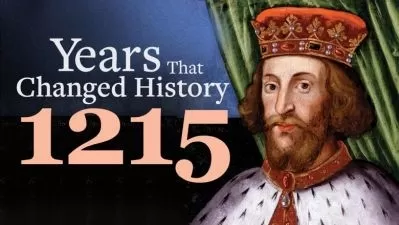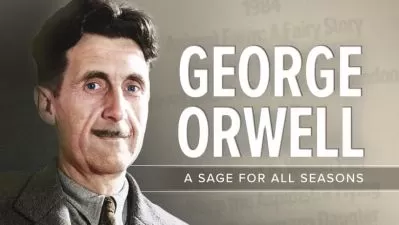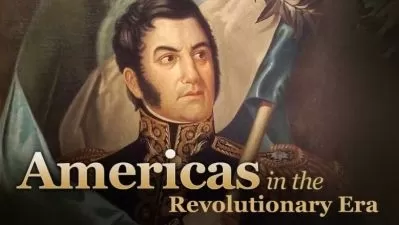The Middle Ages around the World
Joyce E. Salisbury
12:20:59
Description
The Middle Ages cover the 1,000-year period from the fall of the Roman Empire (roughly 400 CE) to the beginning of the Renaissance (1400 CE). Contrary to its earlier designation as the “Dark Ages,” the Middle Ages was a time of profound historical shifts and transformations, that in many ways would shape the modern world. Far from being a “dark” or backward epoch, this extraordinary period reverberates with discoveries, innovations, events, and historical processes that are integral to the world we know now.
The calendars we use today, and the ways in which we think about time and its measurement, date to the Middle Ages, in the medieval creation of the Christian, Jewish, and Islamic calendars. Core features of the global civilization we know now came into being in the Middle Ages, such as agricultural and technological innovations that made huge populations possible. Likewise, numerous other inventions that are essential to our world date from the Middle Ages, such as mechanical clocks, suspension bridges, gunpowder, paper, compasses, odometers, and the banking system.
Then there is the medieval mathematical revolution, which started in the Islamic world and transformed Europe, that gave us the number zero, negative numbers, decimals, fractions, and algebra. Though quite different from the solidity of mathematics, the ethos of romantic love, which permeates our world from literature to popular culture and movies, was also a creation of the Middle Ages—a “game of love” of the nobility that was handed down through influential literary works such as the Romance of the Rose and The Tale of Genji.
And the remarkable intellectual expansion of the High Middle Ages, which produced a global movement toward education and empirical observation, led to Western universities and set the stage for both the Renaissance and the modern scientific revolution.
In The Middle Ages around the World, celebrated medieval scholar Professor Joyce E. Salisbury leads you on a sumptuous tour of this revolutionary time, highlighting the many seminal developments of the medieval era that illuminate our understanding of the world. As a key point of this course, the extraordinary historical currents and advances of the Middle Ages unfolded not only in the West, but across the globe, from Europe, Africa, and the Middle East to Asia, the Americas, and beyond. This course offers a breathtaking panorama of world history, revealing the astonishing scope of the advances and innovations of the medieval era that remain relevant to us today.
Travel across a World-Shaping Epoch
The Middle Ages around the World reveals the vital developments between the era of classical antiquity and the Renaissance, filling in essential stages in the unfolding of human cultures and the creation of the world we know. Early on, you’ll take account of the political disruptions and the fall of ancient empires that began the Middle Ages, as well as the structures of commerce and global trade that so defined these times. From there, you’ll take a detailed and multi-level look at the major features and events of the Middle Ages, as they played out in numerous cultures across the globe.
You’ll visit magnificent medieval cities from Africa and the Byzantine Empire to China; delve into the globe-spanning events of the Age of Faith; chart the growth and reordering of civilizations; and grasp the economic foundations of medieval societies.
You’ll also reckon with medieval engineering, science, and technology, and dig into treasures of architecture, literature, and art. You’ll investigate the features of daily living, across the social classes, medieval exploration and travel, and the wonders of medieval medicine, mathematics, and philosophy. And you’ll track the range of upheavals, warfare, and disasters that brought the Middle Ages to a close.
To know this remarkable period—with its world-changing innovations, human drama, and cultural contributions—is to deeply enrich your understanding of human civilization and history.
The Blooming of Civilization
As you discover the historical dimensions and legacy of the Middle Ages, you’ll delve into fascinating subject matter, such as:
- The Fall and Rebuilding of Empires. Chart the epic story of upheavals and strife that marked the start of the Middle Ages, as the Chinese Han dynasty, India’s Gupta Empire, and the Roman Empire fell, leading to a new order under the Frankish emperor, Charlemagne, in Northern Europe, the Abbasid Caliphate in Bagdad, the Tang Dynasty in China, and the Mongol Empire, among others.
- Expansion, Prosperity, and Networks of Trade. Grasp the innovations in areas such as engineering, agriculture, metallurgy, and energy sources that drove civilizations from Europe to China, bringing population growth, wealth, and global connectivity. Map the great trading networks that undergirded medieval civilization, from the fabled Silk Road to the trading routes within Europe, Southeast Asia, and Africa.
- The Age of Faith. The Middle Ages was a time of vast religious expansion, diversity, and controversy. Witness the currents of thought in the ensuing events, such as the rise of Islam and the advent of Islamic rule; the drama and disaster of the Crusades; Buddhism’s spread throughout Southeast Asia, China, and Japan; and the internal schisms within Islam, Buddhism, and Christianity.
- Medieval Treasures of Art and Architecture. Explore the triumphs of medieval architecture, from European castles and Islamic palaces to gothic cathedrals and the sublime religious monuments of Indonesia, Cambodia, and China; delve into the extraordinary medieval literary works that still move us, from the great heroic epics to the literature of romantic love.
- The Phenomenon of Travel. Learn how travel became both an idea and an ideal in the medieval world; visualize the amazing sea voyages of the Vikings and the Polynesians; see how the Mongols traversed the Eurasian continent, building a vast empire; and travel Asia and the Far East in the company of legendary travelers, Marco Polo, Ibn Battuta, and Lady Nijo.
- The Medieval Americas. Witness the ingenuity in farming, hydraulics, building, and astronomy that gave us the New World’s majestic and intriguing cultures; study the economies, religions, and monumental architecture of the Maya in Mexico, the Chaco Canyon peoples in North America, the Chimu civilization in Peru, and the forest peoples of the Amazon.
- Struggles and Disasters of the Late Middle Ages. Track the calamities of climate change, the Black Death, religious upheavals, warfare, and the disintegration of empires that brought the Middle Ages to a close, accompanied by profound societal changes such as the ending of feudalism, and an emerging worldview that paved the way for the Renaissance.
Experience the Rich Human Drama of These Times
Professor Salisbury brings to the course a phenomenally broad and rich knowledge of the medieval world, plus a flair for revealing the global connections between cultures, peoples, and currents of thought that give the Middle Ages their extraordinary human dimensions.
Among a wealth of memorable details within the lectures, you’ll learn about the weaponry and tactics of armored knights, about lifestyle and diet within medieval palaces, and how medieval Muslim physicians performed complex medical operations for cancer and for cataracts of the eyes. And you’ll meet some of the era’s most remarkable human beings, such as the fabulously wealthy Malian emperor, Mansa Musa; China’s Empress Wu Zetian, who boldly promoted Buddhism; the Abbasid Caliph Harun al-Rashid, whose glittering court was the setting for The Arabian Nights; and Japan’s beloved poet and travel writer Lady Abutsu.
Crossing many cultures, continents, and 1,000 years of history, The Middle Ages around the World offers you a dazzling journey through an epoch that continues to speak meaningfully to the modern world.
More details
User Reviews
Rating
Joyce E. Salisbury
Instructor's CoursesJoyce E. Salisbury is Professor Emerita of Humanistic Studies at the University of Wisconsin–Green Bay, where she taught history and served as associate dean of Liberal Arts and Sciences and director of International Education. She earned her Ph.D. in Medieval History at Rutgers University, specializing in religious and social history.
Professor Salisbury began her career performing research in Spain, and she has continued to travel there to conduct further research, lecture, and guide students and other travelers. She is currently working on a book about the history of early Christian martyrdom.
In addition to receiving the University of Wisconsin’s Outstanding Teaching award, she was named Professor of the Year in 1991 by the Council for Advancement and Support of Education. She has taught three times on Semester at Sea, a study-abroad program on a ship that circumnavigates the world with more than 500 students for a full semester.
Professor Salisbury is a prolific author whose books include the award-winning Perpetua’s Passion: Death and Memory of a Young Roman Woman; The Beast Within: Animals in the Middle Ages; Rome’s Christian Empress: Galla Placidia Rules at the Twilight of the Empire; and the widely used textbook The West in the World. She has been interviewed many times on National Public Radio on topics from religion to the books she has written, and she appeared on the PBS special The Road from Christ to Constantine.

The Great Courses
View courses The Great Courses- language english
- Training sessions 25
- duration 12:20:59
- English subtitles has
- Release Date 2023/08/20
















